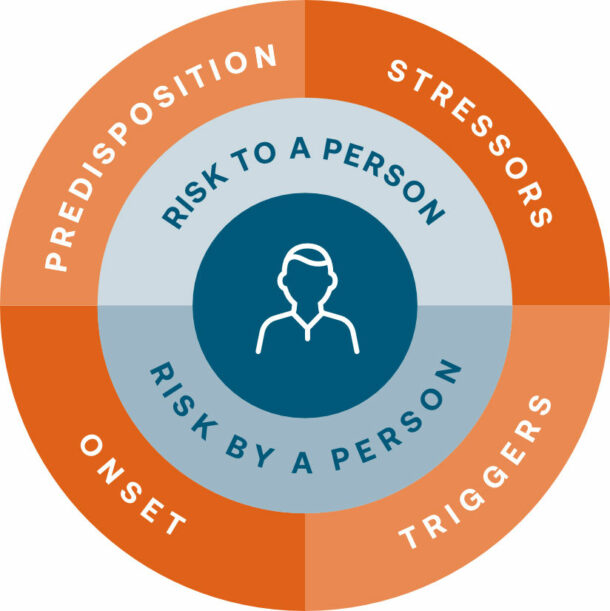Unearthing Leadership Lessons Through the S4R Lens:
Tim's Journey at InnovaNet Solutions
Introduction: Why People are at the Heart of Risk
Leadership can be one of the most rewarding yet complex roles in any organisation. However, when the right conditions and support aren’t in place, even well-intentioned leaders can struggle, with far-reaching consequences for themselves and their teams.
Using Unearth’s System4Risk (S4R), we’ll take a high-level look at Tim’s story. This framework doesn’t just reveal leadership risks; it provides organisations with a tool to identify and mitigate risks in leadership, strategy, and operations before they escalate.
By focusing on three interconnected layers, S4R reveals both risks to people and risks by people, helping organisations build safer, more engaged environments:
- People – Understanding the person at the centre of risk.
- The Risk Lens – Viewing risks to and by the person.
- The Risk Model – A person’s unique ‘Risk Cocktail,’ where we explore four key components: Predisposition, Stressors, Triggers, and Onset


Layer 1: People at the Centre – Tim
At the heart of S4R lies a simple truth: people are both your greatest asset and your greatest risk. Tim entered a leadership role at InnovaNet Solutions (INS) full of ambition, believing that his previous successes would translate to this new environment. Unfortunately, this role demanded more hands-on leadership than he was prepared or skilled for.
Without suitable support or self-awareness, Tim’s leadership style triggered disengagement in his team, and eventually, in himself.
The Risk Lens sharpens our understanding by categorising risks in two ways: risk to a person and risk by a person.
Layer 2: The Risk Lens
The Risk Lens sharpens our understanding by categorising risks in two ways: risk to a person and risk by a person.
Risk to Tim
Tim faced significant risks in his role:
- Environmental risk: INS’s Australian branch lacked the structured systems and mentorship that Tim needed to succeed.
- Personal pressures: His desire to provide for his family created internal stress.
- Workplace challenges: Conflict with team members and growing scrutiny from overseas leadership heightened his stress levels.
These risks contributed to Tim’s disengagement, undermining his ability to lead effectively.
Risk by Tim
Tim’s behaviours, shaped by his stress and lack of adaptability, created risks for the organisation:
- Inconsistent leadership: Tim oscillated between authoritarian control and attempts at camaraderie, confusing and frustrating his team.
- Favouritism: Elevating Natalie to a key role without addressing team dynamics created resentment and further alienated team members.
- Deflection of accountability: Tim’s reluctance to take ownership of his mistakes led to quick-fix solutions that exacerbated the underlying problems.
These risks culminated in a toxic work environment, resignations, and ultimately, Tim’s abrupt departure.
Layer 3: The Risk Model – Tim’s Risk Cocktail
The Risk Model helps us take a holistic view of Tim’s journey by examining four key components: Predisposition, Stressors, Triggers, and Onset.
Predisposition
Tim’s life journey and experiences shaped his leadership mindset:
- His past success leading a mature team gave him the belief that rigid processes and authority would yield quick results.
- His strong ambition to achieve professional recognition drove him to focus on outcomes over team development.
- His personal values around providing for his family heightened the pressure to succeed.
This predisposition left Tim unprepared to lead a developing team in a high-pressure environment.
Stressors
Stressors are environmental factors that add pressure to a person. For Tim, these included:
- Internal: The self-imposed expectation to quickly prove his value in the new role and the feeling of being exposed.
- External: The lack of mentorship and support, conflict with team members, and scrutiny from senior leadership.
These compounding stressors pushed Tim closer to his breaking point.
Triggers
Triggers are events that heighten stress and can provoke significant behavioural shifts. Tim experienced several key triggers:
- Team resistance: His team’s difficulty adapting to his processes undermined his confidence and authority.
- Employee conflict: Clashes with a tenured employee escalated tensions, forcing Tim to take drastic actions that damaged team morale.
- Leadership scrutiny: Senior leadership’s investigation into team complaints added to Tim’s stress, causing him to disengage further.
Onset
Onset occurs when a trigger leads to observable or concealed changes in behaviour. For Tim, these included:
- Observable: Sporadic presence in the office, inconsistent leadership tactics, and increased reliance on quick fixes.
- Concealed: Likely feelings of inadequacy and fear of failure, masked by deflection and justifications for his actions.
These behavioural changes marked the point where risk to Tim became risk by Tim, creating a downward spiral for both himself and the organisation.
Key Takeaways and Lessons Learned
- Adaptability is Essential: Leadership requires tailoring your approach to the needs of your team and environment. Tim’s failure to adapt his methods contributed to team disengagement, poor results, and organisational risks.
- Support Structures Matter: Organisations should provide new leaders mentorship, resources, and regular check-ins to help them navigate complex challenges. These efforts should also align with the organisation’s purpose and values, ensuring leaders have a clear foundation to guide their decisions and actions.
- Self-Awareness Drives Growth: Tim’s inability to reflect and take accountability limited his ability to learn and improve. Leaders must regularly seek feedback, challenge assumptions, and develop a growth mindset.
- Engagement is a Strategic Advantage: Actively engaged leaders and teams are more resilient and effective. Conversely, disengagement creates risks such as absenteeism, poor performance, and even sabotage. After all, you will drive results only by working with and through your people.
- Proactive Risk Management: By using tools like the S4R framework for both individuals and roles, organisations can better understand and mitigate risks before they escalate, ultimately protecting their people and performance.
Final Reflection
Tim’s story is not unique. Many organisations face similar challenges when promoting leaders without the necessary support or self-awareness. The System for Risk (S4R) offers a powerful lens to uncover (even at the point of interview, promotion, or team planning) and address these dynamics, enabling organisations to build safer, more engaged environments where both people and businesses can thrive.
Ask yourself:
How well does your organisation understand the risks to and by its people? Are you equipping your leaders with the tools they need to adapt and succeed?
It is also worth noting that this is only one type of application at a very simple and high level of S4R. The versatility and power of S4R can be applied in a range of ways.
Learn More
If you’d like to learn more about the System for Risk (S4R)—which forms part of the PROTECT framework—and how it can be effectively applied as a leadership superpower, there are two great ways to get started:
- Grab a copy of my book, Risk Starts and Ends with People, which explores S4R and other powerful risk management tools in depth.
- Explore The 9-Week PROTECT The House Program, the first step in the Risk Rebel Leadership Pathway, designed to help leaders transform risk management by empowering and engaging their people.
Both resources will equip you with the insights and strategies you need to harness the full potential of people-centred risk management.
Ask yourself:
How well does your organisation understand the risks to and by its people? Are you equipping your leaders with the tools they need to adapt and succeed?
It is also worth noting that this is only one type of application at a very simple and high level of S4R. The versatility and power of S4R can be applied in a range of ways.
"The greatest risk to an organisation isn’t the uncertainty of the external world—it's the disconnection within its people. When leaders understand that risk and opportunity are two sides of the same coin, they unlock the power to build resilient, thriving teams."
Lisa Sisson